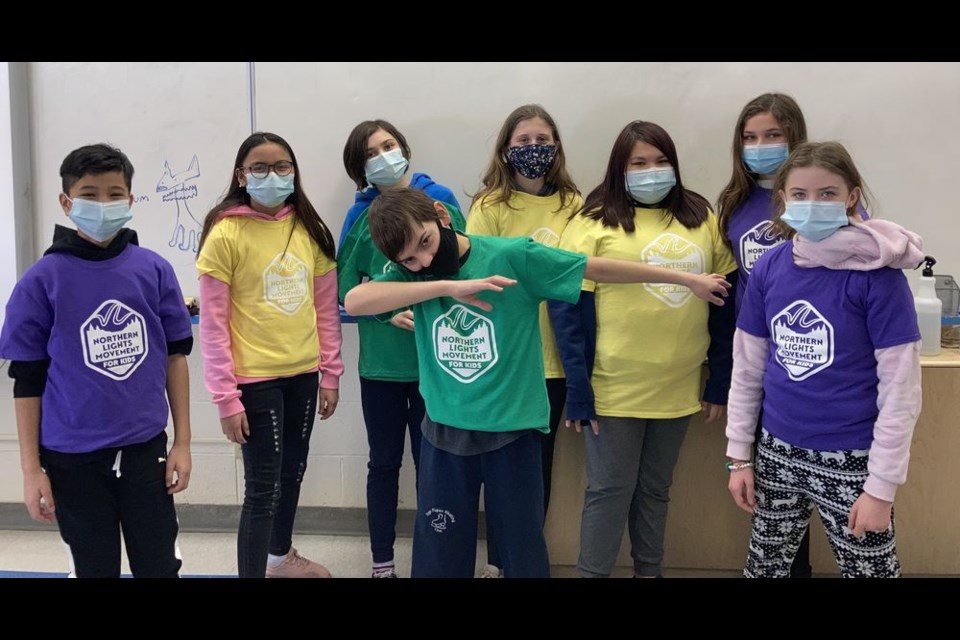The Northern Lights Movement for Kids: The Great Prairie Race is an event that involves Indigenous and primarily non-Indigenous classes, schools, or teams from participating prairie provinces. Schools are invited to challenge each other to get in motion by walking, running, or wheeling the distance to each other’s communities.
KCI students were invited to join the Great Prairie Race by a former KCI teacher, Greg Thomas, who currently teaches Grade six in Air Ronge. Accepting the challenge means the students, along with their teacher, walk 1 km daily with the overall goal to walk the distance between the two communities. To begin, each group maps out a 1 km route in their community. The distance between Kamsack and Air Ronge is an estimated 615 km.�� If 15 students go for a 1km walk, it counts as 15km towards the goal. For KCI, it was Cara Shabatoski’s Grade six class who started the challenge at the end of November. So far, the KCI class has logged 321 km toward their goal.
In addition to the fresh air movement, a social component of the program offers students the chance to get to know the community they are partnered with. The two classes have been meeting bi-weekly over Zoom to discuss program topics such as: which treaty territory they live in, the population of each community and school, healthy seasonal activities they like to engage in, and community traditions. Students were also encouraged to identify positive role models from each community and articulate why they are admired.
Shabatoski and her students have been loving the daily 1 km walks around the schoolyard. In fact, Shabatoski said the students look forward to walking daily and make sure to ask her about it on the days she doesn’t schedule it in.��
“Walking daily has helped my students burn off excess energy and has helped them to stay focused during the day,” reported Shabatoski. “We will continue to walk daily for the rest of the year, even after we have met our 615km goal.”
When asked why she was participating in the Great Prairie Race, one grade six student, Grace Shabatoski said, “To stay active and to communicate with other kids from Saskatchewan.”
��
“To communicate with others and get to know them,” offered student, Bethany Walterson.
The students are also enjoying learning about a life in a different community. “We are learning what it’s like where they live, and how they like the walk,” offered Ally Warriner.
When asked how the students feel about the program, Cage Clark responded, “Very, very good! Glad I have time to run and burn some energy.”
“It’s educational. I like learning about Air Ronge and I’d like to learn about other communities,” pondered student, Joseph Straightnose.
The Northern Lights Movement for Kids is contextualized by Canada’s largest class action lawsuit, the Indian Residential School Agreement, and the resulting establishment of the Truth and Reconciliation Commission (TRC).
In 2015 the Truth and Reconciliation Commission of Canada issued their final report which included 94 Calls to Action. The Calls to Action were intended for all Canadians to work together and begin the process of reconciliation. Section 63(iii) of the TRC Calls to Action states, “we call upon the Council of Ministers of Education, Canada to maintain an annual commitment to Aboriginal education issues, including: building student capacity for intercultural understanding, empathy, and mutual respect.”
The Northern Lights Movement for Kids was inspired by Celeste Leray-Leicht’s reflection that since the release of the Truth and Reconciliation Commission’s (TRC) Calls to Action in 2015, Saskatchewan continued to witness manifestations of disparity and hopelessness including the tragedy in the northern village of La Loche in 2016 and the ongoing youth suicide crisis in Saskatchewan.
In 2018, the Humboldt Broncos tragedy claimed the life of Celeste’s son Jacob Leicht. It was in the days following that tragedy that Celeste’s personal Call to Action precipitated the Northern Lights Movement for Kids.
The intention of the Northern Lights Movement for Kids is to provide opportunities for youth from Indigenous and primarily non-Indigenous communities to build relationships, make connections and serve others.
Initially it began with making connections to La Loche. A pen pal relationship with students from a variety of classes from Ducharme Elementary School and Dene High School in La Loche emerged. Students from Dene High School came to the Greater Saskatoon Catholic Schools’ Student Leadership Conference last fall and met with students from St. Dominic and St. Augustine Schools in Humboldt. The students then met virtually after the Student Leadership Conference and took a virtual tour of Saskatchewan together, especially the communities of La Loche and Humboldt. Ducharme Elementary School in La Loche has now joined in the ‘Great Prairie Race;’ promoting it to as many schools as possible throughout the prairie provinces.
Leray-Leicht said a website for the initiative will be launched soon. The next step is to apply to become a non-profit organization.




